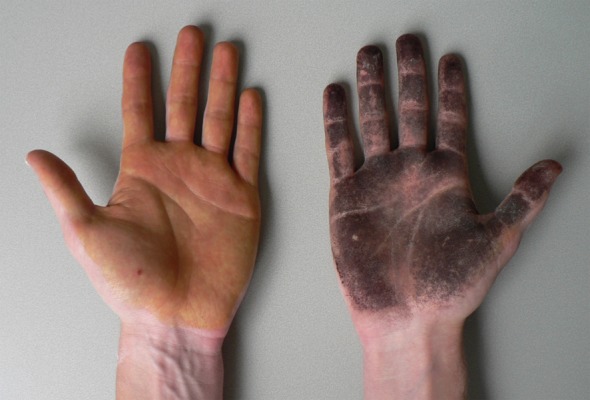Abstract
Damage to the thoracic sympathic chain is a rare complication of video-assisted thoracic surgery (VATS) pleurectomy. We report our experience with a patient who underwent parietal pleurectomy and bullectomy by VATS and postoperatively suffered from palmar anhydrosis and compensatory controlateral hyperhidrosis. The possible mechanisms of nerve damage and various techniques of performing pleurectomy are discussed.
Keywords: Video-assisted thoracic surgery, Sympathic chain, Pleurectomy
INTRODUCTION
Pleurectomy with or without apical bullectomy is an important part of the treatment for recurrent pneumothorax. Currently, the procedure is often performed by video-assisted thoracic surgery (VATS). Although complications are generally rare, well-known complications include bleeding, prolonged air leakage, infection, postoperative pain and the need to convert the access into thoracotomy. In this case report, we describe a rare complication after VATS pleurectomy for recurrent pneumothorax.
CLINICAL SUMMARY
A 33-year old male with alpha-1-antitrypsin deficiency suffered spontaneous left pneumothorax 2 years previously, which was successfully treated with thoracic drainage. At present, he was admitted with a recurrent left pneumothorax. A VATS procedure was performed, showing apical adhesions with small bullae. After adhesiolysis and bullectomy, using a stapler device, parietal pleurectomy was performed by both blunt and diathermic dissection. A ring clamp was used as grasping instrument to remove the pleura by traction and the can opener or spaghetti technique [1, 2]. Diathermic dissection was used whenever necessary, particularly for the first diathermic incision starting 2 cm lateral and parallel to the sympathetic chain. Unipolar diathermy energy was set at level 45. The parietal pleurectomy was limited to the upper half of the hemithorax and started by removal of the pleura at the apex, down over the convexity of the lung to the level of the fifth rib. Laterally, the pleura was fully removed. The posterior border was outlined 2 cm from the sympathetic chain. The anterior border was outlined few centimeters lateral to the mammary artery. Recovery was rapid, without any air leakage from the first postoperative day. The patient was discharged on day 3 without complaints and with a normal chest radiography.
Six weeks later, he presented with complaints of a continuous dry and warm left-hand palm and increased palmar and axillary hidrosis on the right side. The right-sided hyperhidrosis did not extent to other parts of the body. There were no signs of Horner's syndrome and no signs of facial or neck dryness. Left palmar anhidrosis and right palmar hyperhidroses were confirmed by a starch–iodine test (Fig. 1). Because complaints did diminish after observation, we decided, in consultation with the patient, to follow a wait-and-see approach. However, if complaints do persist, a right-sided sympathectomy will be considered.
Figure 1:

Left palmar anhidrosis and right palmar hyperhidrosis were confirmed by a starch–iodine test (deep blue colouration by the formation of polyiodide chains from the reaction of starch and iodine in the presence of H2O).
DISCUSSION
Secondary spontaneous pneumothorax is a known event in patients with alpha-1-antitrypsin deficiency as a consequence of underlying lung disease. Bullectomy with apical parietal pleurectomy is generally accepted as the gold standard approach with very low recurrence rates, classically performed by thoracotomy and recently by VATS in most centres. We performed a bullectomy with apical parietal pleurectomy by VATS using blunt and diathermic dissection.
Although we routinely remove the posterior pleura up to 2 cm anterior of the sympathetic chain, left palmar anhidrosis in this case must be explained by damage to the sympathetic chain or rami communicantes on the T2-T4 level. There were no adhesions at the level of T2–T4, and we did not experience difficulties in visualizing this area. It may therefore be hypothesized that the collateral damage of the diathermic dissection may have injured the sympathetic chain. An alternative explanation may be found in damage to the nerve of Kuntz, a nerve described by Kuntz in 1927 connecting the sympathetic chain with the second thoracic nerve, ascending over the second rib, with considerable anatomical variation. The nerve of Kuntz is present in 40–80% of the population [3]. The possible mechanism of damage may be found in the use of diathermy or mechanical disruption.
Although there is no consensus as to what technique is to be preferred for parietal pleurectomy, less forceful dissection with lower diathermy energy supply may be safer for surrounding structures. These techniques include pleural abrasion and the can opener or spaghetti technique by winding up pleural flaps as described by De Bruyne et al. [1] and Nathan et al. [2].
Interruption of the upper thoracic sympathetic chain is a commonly used technique for the treatment of palmar and axillary hyperhidrosis [4]. A significant proportion of these patients have complaints of compensatory hyperhidrosis in the lower half of the body. Interestingly, the presented patient also suffered from compensatory right-sided palmar hyperhidrosis caused by left-sided sympathetic chain damage. It was not the anhidrosis, but the compensatory right-hand hyperhidrosis that was most disturbing to the patient, with significant discomfort and social impact in a handshaking culture.
Conflict of interest: none declared.
REFERENCES
- 1.De Bruyne C, Vanderschueren RG, Van Swieten HA, Claeys D, Muysoms F, Flamme A. A simplified thoracoscopic technique in performing pleurectomy for spontaneous and recurrent pneumothorax. J Am Coll Surg. 1994;179:741–3. [PubMed] [Google Scholar]
- 2.Nathan DP, Taylor NE, Low DW, Raymond D, Shrager JB. Thoracoscopic total parietal pleurectomy for primary spontaneous pneumothorax. Ann Thorac Surg. 2008;85:1825–7. doi: 10.1016/j.athoracsur.2007.11.043. [DOI] [PubMed] [Google Scholar]
- 3.Marhold F, Izay B, Zacherl J, Tschabitscher M, Neumayer C. Thoracoscopic and anatomic landmarks of Kuntz's nerve: implications for sympathetic surgery. Ann Thorac Surg. 2008;86:1653–8. doi: 10.1016/j.athoracsur.2008.05.080. [DOI] [PubMed] [Google Scholar]
- 4.Sugimura H, Spratt EH, Compeau CG, Kattail D, Shargall Y. Thoracoscopic sympathetic clipping for hyperhidrosis: long-term results and reversibility. J Thorac Cardiovasc Surg. 2009;137:1370–6. doi: 10.1016/j.jtcvs.2009.01.008. [DOI] [PubMed] [Google Scholar]


